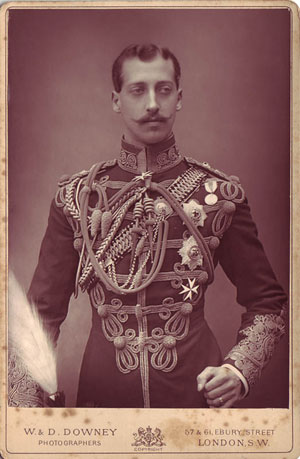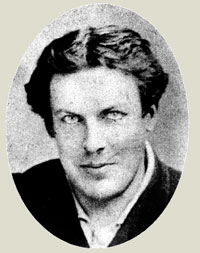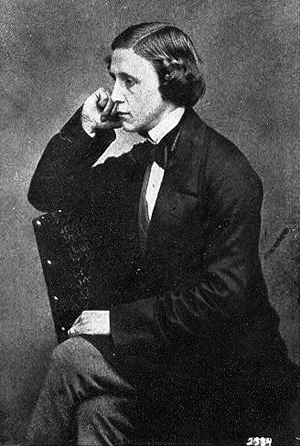
As we saw in Part 1 of this story, there are many theories on the real identity of Jack the Ripper doing the rounds, which range from the hypothetically plausible to the palpably absurd. Delving a little deeper, it is interesting to note how many of the suspects suggested over the years involve highly respected figures from the very top of Victorian society. Perhaps this should not be entirely surprising, as there is a strong and distinct social element in the Jack the Ripper story and its lasting emotional resonance. The Ripper scandal drew attention to the squalor and abject poverty of the East End of London where the murders took place, and the extreme inequalities that riddled complacent Victorian society. Recently uncovered census records have revealed that in 1881 (7 years before the murders took place) several of the Ripper’s victims were living with husbands and families. Presumably, in the years before 1888, these marriages must have disintegrated, with consequences for the abandoned women that eventually led them into prostitution.
There is a case to be made that part of the outrage over the murders was (and is) prompted not just by the barbarity of the acts themselves, but also by a feeling of shared guilt, that society as a whole could allow fellow human beings to fall so low and be forced into such dangerous and degrading means of survival. In this version of the narrative, it is fitting that many should seek to cast the grandees of Victorian Society in the role of Jack the Ripper. The story seems to work better (and certainly have more moral impact) if the Ripper was socially the polar opposite of his victims, his calculated murders being only an extreme, twisted version of polite society’s cold indifference. This perspective on events has developed over time. Contemporary suspects more often than not lived amongst, and in similar conditions to, their supposed victims, and included many immigrants, and known domestic murderers. As time has passed, however, new information on the always shifting, historically invisible community of Whitechapel has become harder and harder to obtain, necessitating perhaps a shift away from simple homicide on a human, local scale, and towards grand conspiracy theories and elaborate whodunit yarns, with ever more unlikely culprits.
Given this line of investigation, there could be no more perfect candidate for Jack than a royal, and it so happens that the contemporary royal brood had a black sheep who could quite easily be made to fit the bill, and has been the subject of not one but three distinct Ripper theories. Prince Albert Victor (always known as Eddy) was grandson to Queen Victoria and son of Prince Albert Edward, and as such stood to inherit the throne on the death of his father. But somehow, even amongst the Hanoverians (for whom spectacularly fractured and unhappy families were something of a tradition), Eddy seems particularly awkward, never quite fitting the role he was destined to play. He was an odd, listless character. Opinions vary over his lack of intelligence, but the argument is only over its extent not its existence, with assessments ranging from his tutor’s report that his mind was ‘abnormally dormant’, to persistent but unverified rumours that he had learning disabilities. Lack of intelligence was, however, no impediment to a young prince gaining admission to Cambridge, and he was helpfully excused from examinations during his time there from 1883 to 85.

As he entered adulthood, Eddy found himself in the unusual position of being simultaneously renowned as a ladies man and reviled as a homosexual. In 1889, his name became involved in the Cleveland Street Scandal, in which it emerged that several high-profile figures (including an Equerry to the Prince of Wales) were clients at a male brothel. All homosexual acts between men were illegal at this time, and punishable by up to two years’ imprisonment with hard labour, so these were serious accusations. However, it seems there was no evidence linking Eddy to the establishment, and his name was probably only thrown into the mix to distract attention from those who had actually been involved. Keen to avoid a scandal (having already created quite enough of his own), Eddy’s father stepped in to make the matter go away, effectively ending the investigation into the affair. This ultimately seems to have done more harm than good, the cover-up encouraging gossips to believe that Eddy did in fact have something to hide. Certainly, whispers of homosexuality (which seem to have very little grounding other than this case) have clung to him ever since.
Like his father, it seems Eddy also had dalliances with a string of women, leading to other scandals, including Margery Haddon’s (almost certainly false) claim that he was the father of her son, and subsequent blackmailing by the ‘son’ himself. In 1891, he was also blackmailed by two prostitutes who claimed to be in possession of compromising letters written in his hand. Though these claims, too, are now thought to have been fraudulent, there is little doubt that Eddy had his fair share of amatory adventures, and it is has been widely claimed that at some stage he contracted a venereal disease, possibly gonorrhoea.
The increasingly vexed question of Eddy’s eminent unsuitability to ever assume the crown was abruptly resolved in 1892, when he died, suddenly. The cause of death was officially recorded as influenza, though the shocking timing of his death, aged just 28, has prompted further conspiracy theories that he was poisoned, or pushed off a cliff, or that his death was faked in order to remove him from the succession.
Mix all of these elements together and you have a stew whose peppery aromas would attract any Young Turk looking to make his mark and his fortune on the Jack the Ripper scene. Although there is no evidence of anyone making the connection at the time of the murders, Eddy has subsequently become the linchpin of several theories.
Theory One: The Lone Madman
This theory, originally popularised by Dr Thomas Stowell in 1970, did not name Eddy directly, but there is enough evidence in his explanation to make it clear who he is referring to. According to this account, Eddy was suffering from syphilis, exotically contracted in the West Indies, which drove him mad and set him on the murderous course of Jack the Ripper. The royal family is said to have known that Eddy was the killer from at least the second murder, but did not act until after the fourth, when he was locked away in an asylum. He somehow escaped to murder Mary Jane Kelly, at which point he was re-interred and died of ‘softening of the brain’ in a private mental hospital at Sandringham.
Stowell died shortly after publishing this theory, and his papers were destroyed by his family. This has made many elements of the story impossible to substantiate. More damagingly, official records show that Eddy was not in London on the murder dates (but then, they would do, wouldn’t they?).
The theory was elaborated by Frank Spiering, who claimed to have seen notes of royal physician Sir William Gull, in which he described hypnotising Eddy and watching in horror as he acted out the Ripper murders. When the New York Academy of Medicine, Spiering’s stated source for this material, claimed that it had no such records, Spiering went on to challenge the Queen to throw open the royal archives and publicly reveal the truth about Eddy’s murderous secret. When the royal household said they would gladly allow Spiering access to the archives (as they will to anyone who applies), Spiering stroppily replied that he didn’t want to see the files anyway, so there.
Bunkometer Rating: A theory which, aside from being based on a paper trail which no-one can prove exists, seems to offer no tangible connection between Eddy and the murders, other than that he had a sexually transmitted disease and therefore must have despised all women madly, and killed a string of them. Codswallop.
Theory Two: Eddy As Jack’s Muse

Accepting that the idea of Eddy as Jack the Ripper has colander-level water-holding abilities, but unwilling to leave him out of the story entirely, another theory has emerged with Eddy the unlikely inspiration for enough searing sexual jealousy to fuel the fires of history’s most infamous serial killer. This theory, advocated by Michael Harrison, centres around James Kenneth Stephen, a poet, and Eddy’s tutor at Cambridge (as well as cousin of Virginia Woolf).
Stephen was undoubtedly an unusual character, and any hint of being a little bit odd is blood in the water for your second-rate Ripper researcher. It is undeniable that some of Stephen’s poetry did contain a misogynistic streak. Take, for example, his poem In the Backs, which contains the following lines about a woman he comes across and takes an instant disliking to,
…I do not want to see that girl again:
I did not like her: and I should not mind
If she were done away with, killed, or ploughed.
She did not seem to serve a useful end :
And certainly she was not beautiful.
Chilling words, certainly, but is it any more than poetic hyperbole? Harrison certainly seems to think so. According to his version of events, Stephen fell passionately in love with Prince Eddy during his time at Cambridge, and Eddy initially responded to his advances, entering into a sexual relationship. Soon though, Eddy grew tired of Stephen, and took the excuse of his enrolment in the army to end the affair. Less controversially, two years later Stephen suffered a brain injury, as a result of either being hit by an object falling from a moving train, or far more romantically being thrown by his horse into the spinning vane of a windmill. Thus began a period of mental deterioration, culminating, says Harrison, in complete insanity.
Enraged by Eddy’s widely rumoured flings with women, whom he clearly lusted after in a way Stephen had never been able to inspire, Stephen determined to take his revenge on an entire gender by committing the Ripper murders. Precisely why Stephen should pick these East End prostitutes as way of hurting Eddy is not fully explained.
Bunkometer Rating: This theory seems to be based on the apparently groundless belief in Eddy and Stephen’s homosexuality, and yet again relies on an implied and murky, yet clearly direct and unswayable, relationship between sex, madness and the murder of prostitutes. In going to far greater lengths to establish the suspect’s immorality and strangeness than any direct link to the murders, it’s as if the author is suggesting that, in effect, the former proves the latter. Crapola.
Theory Three: The Royal Conspiracy
Everyone likes a conspiracy, and this one is so juicy that it has gained a lot of ground in recent decades, and has frequently been portrayed in television, film and popular books.
Based on the claims of Joseph Gorman, this version of events holds that Eddy secretly married and had a child with a Alice Mary Crook, a Catholic shop assistant (of all things!) in the East End. On hearing of this brewing scandal, the royal family, including Victoria herself, formed an unholy alliance with (you guessed it) the Freemasons to cover up the awful mess. Key figures, including Lord Salisbury and, yet again, royal physician Sir William Gull, masterminded a plot to eliminate everyone who knew about Eddy’s child, and at the same time send a powerful coded message, broadcasting the abiding power of the freemasonry. For some reason, the motley crew stopped short of killing Alice, instead whisking her off to an asylum where Gull conducted experiments on her to make her forget what had happened, and plunge her into lunacy.
Bunkometer Rating: Balderdash! Eddy plays only a supporting role in this one, his accepted profligacy making him a suitable donor of the wild royal oats needed to get this potboiler going. There are several gaping holes here: notably why was Alice not murdered, and how is it that the covering up of this ripe rumour only necessitated the killing of five women, all of them prostitutes? The final nail in the coffin should have been Joseph Gorman’s later admission that he had made the whole thing up, but the rumour is out in the wild now, and seemingly unstoppable.
What all of this seems to suggest is that the British, as affectionate as many of them are towards the royal family, take only a very little prompting to believe that this august and ancient institution has a dark, rotten heart, and a mind programmed entirely differently from our own. The fact that such flimsy theories, contradictory of each other and often of themselves, have gained any currency at all reflect our willingness to see the royals as characters in the vividly painted, infinitely flexible story of history rather than as fellow human beings, operating in a unique but real set of social circumstances. But then, we needn’t have looked to history to highlight that.
Anyone for another Diana enquiry?
Further Reading
- Casebook: Jack the Ripper (site) – a refreshingly sober and sceptical but still engaging guide to the world of Ripperology.
